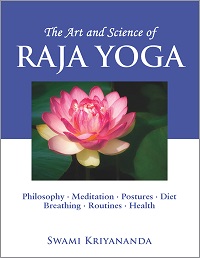 Excerpted from: The Art and Science of Raja Yoga, by Nayaswami Kriyananda
Excerpted from: The Art and Science of Raja Yoga, by Nayaswami Kriyananda
A student of one of my beginning classes in San Francisco, some time ago, drove with me to the Ananda Meditation Retreat in the Sierra Nevada foothills. Halfway through the journey her purse fell open. Out fell an assortment of green pills, yellow pills, blue pills.
“What on earth are you doing with all those pills?” I asked.
“Why, I couldn’t get along without them!” she exclaimed. “I need the green pills to put me to sleep at night. They leave me groggy in the morning, so I take the yellow pills to help me wake up. The yellow pills make me edgy, so I take the blue pills later in the day, as tranquilizers.”
Well,” I said, “you’ve been practicing yoga for two weeks now. Why don’t you try doing a few postures before going to bed, and see if you can’t get along without all those crutches?”
“Impossible!” she cried in alarm. “You don’t know me. I’ve never been able to sleep without them. I’m a complete pill addict!”
After a week, however, she worked up enough courage to try my suggestion. The next day she telephoned me to say that she had never slept so well in her life. A year and a half later we spoke again on the phone. She was still practicing yoga postures. Her dependence on pills had been overcome completely.
Insomnia is one of the miseries of the modern age. This might, indeed, be called the Age of Anxiety. People who fail to get the rest they need at night often resort to heavy doses of coffee and other stimulants to remain awake during the day. They sleep badly the following night as a result of these stimulants, and so by degrees enter a life-cycle that leaves them chronically out of tune with life (or energy) — like an eight-cylinder motor functioning on only one cylinder.
If you are troubled with insomnia, try doing a few yoga postures before going to bed. Get the energy in your body flowing smoothly, instead of leaving it gathered and blocked in local knots of tension. (Physical tension activates relative areas in the brain, making sleep difficult.)
Then lie in bed flat on your back. Inhale deeply; tense the whole body, equalizing the flow of energy throughout the body; throw the breath out and relax. Repeat this alternate tension and relaxation two or three times if you so desire.
Then watch the breath mentally for awhile, allowing its steady rhythm to soothe you, like the waves of an ocean stroking the shore on a calm day.
After some time, inhale deeply; then exhale slowly and completely, as if with a sigh, and feel that you are surrendering yourself to an infinity of peace. Hold the breath out as long as you can comfortably, and repeat mentally, “Aum, peace, peace, amen,” or, “Aum, shanti, shanti, shanti” (Shanti is the Sanskrit word for peace.) Visualize an ocean of peace spreading out in all directions around you — or think of peace as gathering protectingly around you in great, soft clouds. Repeat this breathing process six to twelve times. If after that you are still awake, continue watching the breath, calmly, passively.
Yogis say that one’s bed should be arranged so that its head is not pointed towards the west. A westward position is said to induce fitful sleep and restless dreams; eastward, to aid the development of wisdom; and southward, to promote longevity.
Never go to sleep with the thought that you are utterly exhausted. Not only will the desperate desire for rest often drive sleep away (simply because desperation is the antithesis of repose), but the mental affirmation of exhaustion will be carried into the subconscious mind, and will affect even your wakefulness the next day. No matter how long you sleep, if you go to sleep exhausted, you will probably wake up exhausted.
Any strong thought that you carry into your subconsciousness as you fall asleep will affect your waking state the next day. This principle is said to hold true also for death – the “Big Sleep” – and subsequent rebirth. Above all, therefore, try meditating before you go to sleep. Sow in the fertile soil of your sleepland the nourishing seeds of God’s peace.
Before sleep, and also before meditation, it is better not to eat anything. Especially to be avoided are starchy or other high carbon foods. The heart and lungs clear the body of waste products, expelling them in the form of carbon dioxide. Starches and sugars give the heart more carbon to pump out of the body. A hard-working heart, with resultant heavy breathing, makes perfect rest perfectly impossible.
If you must eat anything just before going to sleep, try taking your food warm (warmth is relaxing) and if possible in liquid form. Yogis recommend warm milk in such cases.
* * *
Sleep “Potion: Although garlic, for culinary purposes, is not generally recommended by yogis, garlic has certain medicinal properties that recommend it in specific cases. If, for example, you boil a little chopped garlic in milk, simmering it for ten minutes, the resulting beverage has been found to induce sleep.
The Raja Yoga Intensive is Ananda’s most popular and most comprehensive experience of the meditative techniques, exercises, and philosophy of the science of yoga. The Art and Science of Raja Yoga serves as the primary text for the course as well as for Ananda’s Home-Study program.




